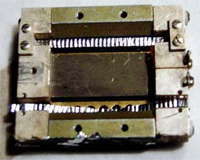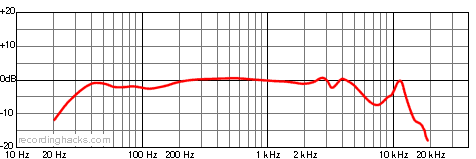 Oktava ML-52
Oktava ML-52
Bidirectional Ribbon Microphone
The ML-52 (aka ML-52-02) is a dual-ribbon microphone created by Oktava in the year 2000. A subsequent revision, in which the internal windscreen has been improved, has been released as the ML-52-01. Both mics feature the same ribbon motor: dual 2.5-micron aluminum ribbons measuring approximately 50mm in length, parallel in the magnetic field.
SoundOnSound
The mic’s sensitivity is 1.6mV/Pa, which is about 10dB higher than that of the classic Coles 4038 ribbon.
 Pictured is the ML-52’s dual-ribbon motor construction, courtesy Larry Killip’s page on ribbon replacement — an interesting page, with input from David Royer, about sourcing, cutting, and corrugating replacement mic ribbons.
Pictured is the ML-52’s dual-ribbon motor construction, courtesy Larry Killip’s page on ribbon replacement — an interesting page, with input from David Royer, about sourcing, cutting, and corrugating replacement mic ribbons.
Like most passive ribbon mics, the noise level of the microphone is virtually nonexistent, although due to its relatively low output level, this mic (like most ribbons) will more quickly reveal noise and distortion in the preamp than would any condenser mic.
Michael Vladimirsky (in 2001)
The “new” Ml-52 was obviously an attempt to recreate the ML-11 and ML-15 bassy sound. This microphone produces, mainly, lower mids. If ML-52’s transformer was as good as they used in the ML-11s, the mic would probably be as good.
Like most inexpensive ribbon mics, the ML-52-02 responds well to basic mods, foremost among these replacing the stock transformer with a high-end part. The Lundahl LL2911 is known to work, although Marik warns that the dual-ribbon motor in combination with a 1:37 transformer can cause impedance-matching problems for the pre.
Damping the mechanical resonances of the vertical grille and domed top is a challenge:
Michael Joly
The top ring of the ML-52-02 is so highly resonant that it takes a clasped thumb and index finger wrapped around the mic case to stop the ringing. Simple solution — take the top off and roll your own wire screen.
…all of which goes a long way to explain why Oktava subsequently released the ML-53, which is the same mic as the ML-52-02 but with a more traditional (and less ringy) screened headbasket.
ML-52 owners interested in modding the mic on their own should see issue #44 (Nov. 2004) of Tape Op Magazine, which contains a howto article by Dave Fisher with detailed instructions for:
- Upgrading the transformer
- Upgrading internal wiring
- Removing a mechanical filter
Bob Crowley, formerly of Crowley and Tripp Microphones, dissected a stock ML52 transformer, and concluded that it compares favorably with models from Jensen, Lundahl, and Sowter in terms of total efficiency.
 Nonetheless, in September, 2009, Oktava retailer Oktava-Online began offering the ML-52-02-L, which swaps the stock transformer of ML-52(-02) with a Lundahl LL2912 transformer.
Nonetheless, in September, 2009, Oktava retailer Oktava-Online began offering the ML-52-02-L, which swaps the stock transformer of ML-52(-02) with a Lundahl LL2912 transformer.
The Oktava ML-52 is also known as: ML-52-02, ML52-02, ML52, ML-52-02-L.
The mic was released in 2000.
Specifications
| Frequency Response - BidirectionalClick Graph to Compare! |
|---|
 |
| Pickup Patterns | Pads & Filters |
|---|---|
|
Bidirectional
(1.6 mV/Pa; 20 - 20,000 Hz) |
|
| Ribbon Construction | Impedance | SPL/Noise |
|---|---|---|
| dual 2.5-micron, 50mm aluminum ribbons | 300 Ohms (Low) | Max SPL: 135 dB |
| Weight | Length | Max Diameter | Interface(s) |
|---|---|---|---|
| 590g (20.81oz) | 185mm (7.28'') | 55mm (2.17'') |
|
| Power Specifications |
|---|
Did we get anything wrong on this page? Please let us know!


